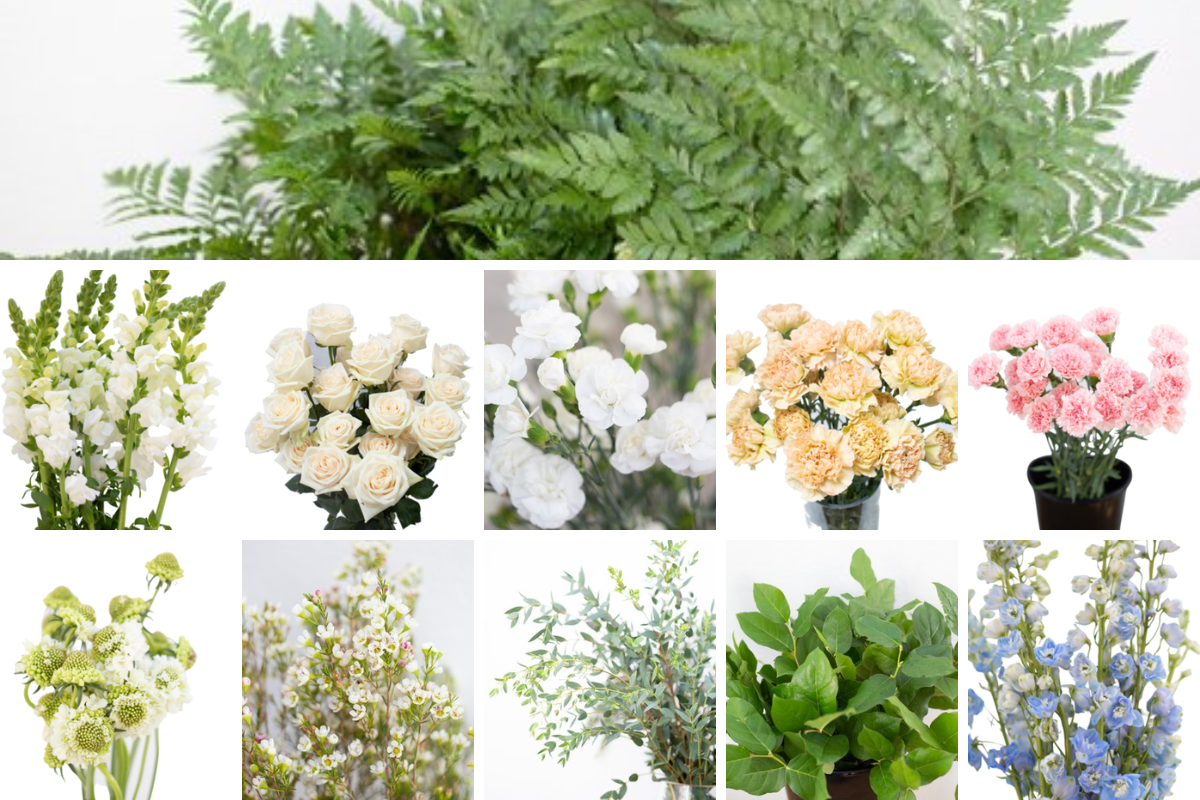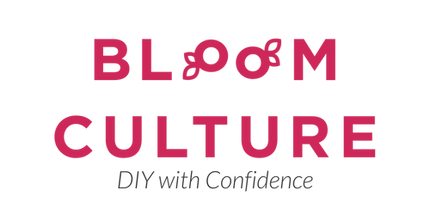Wedding trends keep changing and one continuing trend for 2022 are these gorgeous wedding ceremony pillars. They can vary greatly but we’ve decided to do a tutorial with a simple approach to break down just how to make them. BONUS! We’ve even added in a tutorial on how to DIY the actual pillar structure (super cheap, and super easy!).
Suggested Supplies:
-
Wet Floral Foam - (6)OASIS Floracage Grande Holder - 6 3/4 Long x 4 1/4 Wide x 3 1/8in High
-
(2) Grande Oasis Floral Iglu
-
14" Zip Ties
Here is exactly what we used in this tutorial:
 GREENERY:
GREENERY:
-
1 Bunch Gunni Eucalyptus
-
1 Bunch Silver Dollar Eucalyptus
-
2 Bunch Leather Leaf
-
2 Bunch Lemon Leaf (salal)
*Recipe per Pillar:
FLOWERS:
-
10 Delphinium
-
12 Blush Carnations
-
25 Terra Cotta Carnations
-
10 stems White Scabiosa
-
20 White Mini Carnations
-
25 White Roses
-
10 White Snapdragon
-
1 bu Wax Flower
Here’s what to do:

GREENERY:
We always start with greenery!
-
If you’re new to our design approach, we LOVE greenery. It’s our best friend. Cover’s up our blemishes and makes us look good. In all seriousness though, greenery is the only way to start a foundation of a floral design. If you skip or skimp on it, you will need way more floral which translates into way more money.
-
So greenery. In this design we have four foam cages to work with. I want you to act as if they are all one; meaning at the end of the design, I want the pole to look like a solid group of greenery and flowers instead of four separate groupings on the pole.
-
Start with one type of greenery and work from the bottom to the top. In this design we’ve started with the broad leaf/wide reaching Salal. Distribute the greenery evenly (but not too balanced) up the pillar.
Pro-tip: I say this about 100 times in the video tutorial but I will try to limit it to once in this post. Take a step back periodically and get a better look at the design. Getting a zoomed out vantage will help a TON in placing greenery and floral and make the design flow better.
Starting is the hardest part, this part may feel like a hot mess and that it has ZERO direction. But just keep going. We work in layers and the design gets better with each layer.
-
Once you’ve placed your first variety of greenery we continue on to the next, which in this tutorial we’ve used Leather Leaf. If you started at the bottom with the first greenery, start at the top with this one and work your way down.
Pro Tip: Approach this design as if it had a background, mid-ground, and foreground. PLacing various lengths of various types of greenery in each. Doing this ensures tha you will not have a “solid” or static looking design. It will have depth and dimension. In other words it will look more professional.
-
Continue layering in the greenery with each variety. We’ve used 4 different types in this design. Make sure you cover up the mechanics, meaning cover the foam cages and the PVC pole well. We do have floral to use so at this point if you see some that is totally okay.

Flowers
In this tutorial we start with our Line flowers. Due to the vertical nature of the design, it felt natural to add length and reach first before we added the focal flowers. We will add moments of focus with these in diagonal placements or groupings of threes.
-
Line Flowers: Delphinium and Snapdragon
-
Here I’ve used the gorgeous light blue Delphinium and whtie Snapdragons. I started at the top, creating even longer reach and adding height to the arrangement and move down. I use a few groupings of three as well as create a diagonal line about mid-design. I do this with line flowers because it helps guide the eye up AND down the tall structure. We don’t want all line flowers facing up or benign placed in the exact same fashion as it would start to look very rigid.
-
-
Focal Flowers: Roses
-
Next I layer in our white roses. I used the spin technique on these to open them up a bit more before placing them in the design. Stem length in this design is incredibly important. I use varying lengths throughout the piece to help create depth and connect groupings to one another.
-
One thing to note in this design and especially with the focal flowers. The design should feel lighter at the top. So use “heavier” feeling floral less towards the top. I use about 3 in the smaller top floral foam cage and more towards the base of the design to anchor it.
-
These roses help build the foundation of this design and really carry the design working together with the greenery to cover mechanics and build the bulk of the design.
-
Spray Flowers - Mini Carnations
-
I usually move on to sprays at this point after placing the flocal flowers but in this design it really needs it here! The design will likely look a bit solid and static at this point but the scale of the sprays and their multiple blooms will really break this up. I start at the top again, maybe using a longer stem length here and there to make it feel organic alongside tucking some of these flowers into the design to help with depth and again, add a difference in scale. It really starts to take shape and pick up speed at this point. YAY!
-
Accent Focal Flowers - Carnations
-
Next up are two varieties of gorgeous Carnations. Here we’ve used the infamous Terra-Cotta and the tried and true blush carnations. I call these accent focal flowers because they are large enough at times to be a focal flower but they are mainly to accentuate the color palette and fill in the design. We do create focal moments throughout the design but again, as you can see in the photos and video tutorial. They are not an intense focus, but accentuate the design by bringing another layer of color and texture.
-
The Terra-cotta carnation color is a bit peachy and is used more than the blush carnations. Again starting at the top with a few longer placements but also tucking them in here and there to create some shadow and depth of design. The blush carnations really add a beautiful highlight to the design and I use fewer of them throughout as they are an accent color.
-
-
Detail Flowers - Scabiosa
-
These beautiful detail flowers are used sparingly as they can be pretty pricey and they are meant to add interest in certain areas of the design, but not be the foundation or backbone of the design but a little detail that creates whimsy or movement. I use these sparingly and in very intentional places in the design.
-
Filler Flowers
- Lastly, we work in the filler flowers. Here I’ve used Wax Flower to fill in spots that seem like they need another flower or to break up solid masses such as greenery or roses, etc. They add a different scale and most importantly another texture to the design. Scale, color and texture are huge in making an arrangement look and feel professional.
If you are a more visual learner or need more clarification, please check out our full length tutorial where I walk you through this design process step by step!
Watch to the end for a quick step by step tutorial on how to make the pole/pillar structure!

Here’s what you’ll need:
-
Supplies to make Pillar
-
Two 7” opening Terracotta pot or metal bucket
-
1 bag fast setting Quikrete
-
Water
-
Measuring scoop
-
Stirring device (something you may want to throw away after)
-
Two 10’ tall 2” diameter PVC Pipe (cut down to 6’-8” after they dry vertically in the pots).
-
Hand saw
-
*Optional dark green or black spray paint (we suggest spray painting the white PVC a dark color if so it’s easier to hide and so it doesn’t reflect any light)
-

Leave a comment